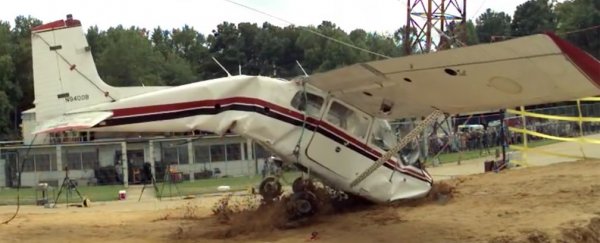Normally the words 'NASA' and 'crash' go about as well together as nuts and gum, but on this occasion we're relieved to say that crashing is all a part of the plan.
As part of its ongoing testing looking into how best to optimise emergency locator transmitters (ELTs), NASA is crashing planes on purpose to record how well the transmitters respond in different collison scenarios. In the event of a real-life plane crash, ELTs are often the first signal alerting rescue personnel that an aircraft has been downed, so they're a vital part of any immediate emergency response to save whatever lives possible.
Unfortunately, due to the severity of many aeroplane crashes, ELTs often don't work the way they're supposed to, as the devices themselves regularly become another casualty when aircraft impact with the ground. NASA's Langley Research Centre in Hampton, Virginia, is looking into ways this can be avoided, seeing how and when ELTs get damaged due to their placement in aircraft, and measuring how different kinds of landing surfaces affect crashes.
In this video, a Cessna 172 held aloft by cables plummets from a height of more than 30 metres into a thick bed of soil, with the collision occuring when the plane is travelling at nearly 90 kilometres per hour. A previous test earlier in the month sent the same aircraft into solid concrete rather than dirt.
While you might think the soil would provide a gentler landing, NASA says the opposite is the case. Concrete crashes encourage skidding along the surface, which dissipates energy, whereas dirt makes aircraft crashes end almost suddenly.
"It's actually worse," said Chad Stimson, a project manager with NASA's ELTs Survivability and Reliability research, in a press release. "[All] that force is absorbed by the airframe and the occupants. This was clearly more severe than the first test. No one would have walked away from this. They might be alive, but they'd need help right away. In that sense, it's the perfect search and rescue case."
NASA's crash-testing records 64 separate channels of data in each crash, with each collision captured from 40 different cameras, all to help researchers better understand the ideal positions to install ELTs. If aircraft designers can give the transmitters the best chance possible of surviving crashes, they in turn can help save the lives of people wounded when aeroplanes come down.
In this crash, the dummy Cessna has five separate functional ELTs, each of which are fully operational, giving them the ability to send data to satellites on impact.
"The cool thing is we're using the whole system," said Stimson. "We get real-time feedback from space… and we're getting first-of-its-kind data to help search and rescue get better outcomes."
